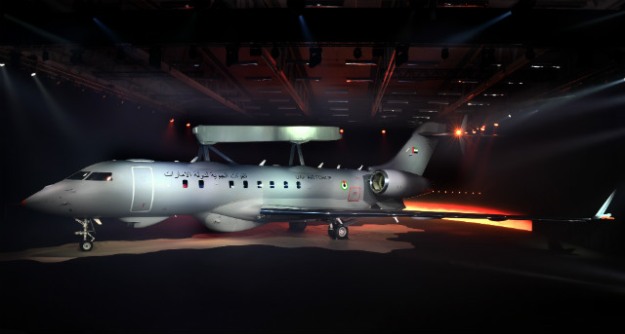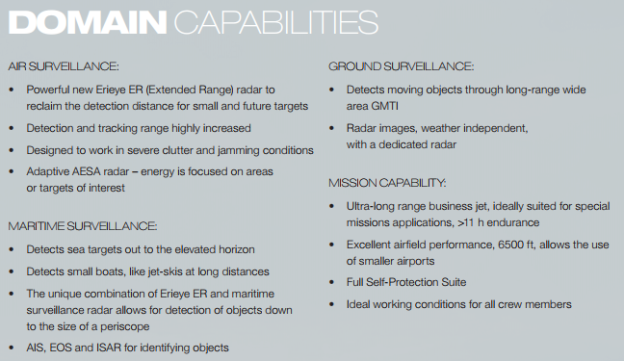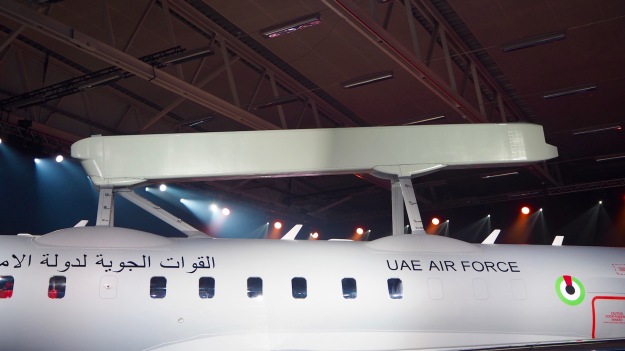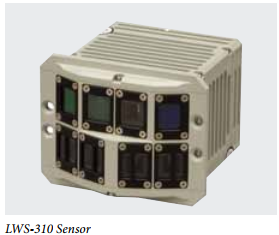GlobalEye airborne early warning and control (AEW&C) aircraft is a new multi-role airborne surveillance system developed by Saab.
The aircraft is capable of offering air, maritime and ground surveillance on a single platform. It can operate in dedicated or multiple roles and has the ability to simultaneously switch between different roles at any point of time during an ongoing mission.
The GlobalEye airborne surveillance system was launched at the Singapore Airshow 2016. Saab received a $1.27bn contract from the United Arab Emirates (UAE) in November 2015, to supply a new airborne swing role surveillance system (SRSS) integrating a new variant of the Saab Erieye radar system based on the Global 6000 aircraft.
Dubai Airshow 2015: UAE signs with Saab for two surveillance aircraft and upgrades
The UAE Air Force and Air Defence (UAE AF & AD) signed a USD1.27 billion contract for the procurement of two new Saab surveillance aircraft and the upgrade of two others, the company said on 9 November.
The contract, which was announced at the Dubai Airshow 2015, will see the UAE receive two of the latest versions of Saab’s Erieye airborne surveillance systems fitted aboard Bombardier Global 6000 business jet host aircraft, as well as the upgrade of the country’s two existing Erieye systems that are fitted to Saab 340 turboprops.
As noted by Saab, the new Swing Role Surveillance System (SRSS) being procured by the UAE is the most advanced version of the Erieye system to date, in that it will provide surveillance capabilities over air, land, and sea. “This is a significant step forward in capability, in that it is effectively a combined AWACS [Airborne Warning And Control System], JSTARS [Joint Surveillance Target Attack Radar System], and MPA [maritime patrol aircraft] in one,” a company representative told IHS Jane’s .
Although not confirmed by either Saab or the UAE, it is understood that the two Erieye systems that have been in service since 2010 will be upgraded to this same standard.
Saab did not reveal delivery timelines for the new contract, citing a request for confidentiality from the customer, not did it provide details of the SRSS system beyond an aircraft model that showed it to be based on the same dorsal ‘plank’ antenna configuration as the baseline Erieye. This baseline Erieye features an electronic-warfare suite that includes electronic support, threat-warning and countermeasures dispensing subsystems, an identification friend or foe (IFF) subsystem, command-and-control (C2) capabilities, and a ground-based mission trainer.
A company representative told IHS Jane’s that the SRSS will not necessarily become the new baseline version of the Erieye to be offered to all future customers, as not every operator will have the need for such an advanced capability. Source: IHS Janes’s
GlobalEye variants
The GlobalEye AEW&C platform is offered in three different configurations according to customer-specific requirements. The base configuration is equipped with the AEW&C capability to deliver aerial, maritime and ground surveillance.
The second variant integrates additional maritime surveillance radar and electro-optical sensors to transform the base platform to offer enhanced maritime and ground capabilities. The third version incorporates new sensors for electronic intelligence (ELINT) and signals intelligence (SIGINT) capability.
Swordfish Multi-Role Maritime Patrol Aircraft (MPA): Details
First UAE Spyplane Breaks Its Cover: Here
In addition to its openly acknowledged procurement of three Saab GlobalEye airborne early warning aircraft, based on Bombardier’s Global 6000 platform, the UAE is also set to receive two further Global 6000s converted for electronic intelligence (ELINT) or signals intelligence (SIGINT) duties under a more secretive programme. Jon Lake reports.
The first of the UAE’s two shadowy spyplanes has been spotted and photographed undergoing pre-delivery testing at Marshall Aerospace’s facility at Cambridge Teversham Airport in the UK.
PICTURE: Saab unveils first GlobalEye for UAE

Saab
Saab has unveiled its first GlobalEye surveillance aircraft, revealing the extensively modified Bombardier Global 6000 business jet in the livery of launch customer the United Arab Emirates air force.
Conducted at the Swedish company’s Linköping site on 23 February, the event came a little over two years after the GlobalEye deal was announced at the Dubai air show in November 2015. The UAE initially signed a two-aircraft order, before also taking an option on a third example last year.
Adaptations include adding a Saab Erieye ER airborne early warning and control radar in a “skibox” fairing above the fuselage, plus a search radar and electro-optical/infrared sensor beneath, enabling the GlobalEye to also perform maritime and overland surveillance tasks.
This combination of sensors aboard an ultra-long-range business jet platform “brings extended detection range, endurance and the ability to perform multiple roles with one solution, including search and rescue, border surveillance and military operations,” Saab says.
“This first aircraft is equipped and being prepared for ground and flight trials to gather aerodynamic data as part of the ongoing development and production programme,” the company adds. It has not disclosed a delivery schedule for the UAE’s new capability.
“This milestone is clear evidence that the GlobalEye programme and Saab are delivering on our commitments,” says Anders Carp, senior vice-president and head of the company’s surveillance business area. Source flightglobal.com
Saab Wins UAE Order for Further Functionality for GlobalEye
Saab has received an order from the United Arab Emirates for additional functionality for the advanced airborne early warning & control (AEW&C) solution GlobalEye. The order value is approximately SEK 345 million (US$ 38.7 million).
The UAE placed its first order for GlobalEye in November 2015.
GlobalEye combines air, maritime and ground surveillance in one swing-role solution. It features a full suite of sophisticated sensors including the powerful new extended range radar (Erieye ER).
“GlobalEye is the most advanced airborne early warning & control solution on the market and the program is progressing very well, with the first flight completed in March this year. This order is further testament to our successful collaboration with the UAE”, says Anders Carp, head of Saab business area Surveillance.
GlobalEye brings extended detection range, endurance and the ability to perform multiple roles, including tasks such as search and rescue, border surveillance and military operations.
Saab serves the global market with world-leading products, services and solutions within military defense and civil security. Saab has operations and employees on all continents around the world. Through innovative, collaborative and pragmatic thinking, Saab develops, adopts and improves new technology to meet customers’ changing needs. Source defaiya.com
GlobalEye AEW&C aircraft design and features
- Latest generation Command & Control
- Operators sideway seated
- Ergonomic seats
- Low cabin noise level and pressure altitude
- 6-seat rest area
The GlobalEye AEW&C system is based on the Bombardier Global 6000 ultra-long range jet aircraft. Its cabin houses ergonomic sideway seating for operators and offers low noise level and pressure altitude. It also accommodates six-seat rest area for passengers.
The aircraft has a length of 30.3m, wing span of 28.7m and wing area of 94.8m². The maximum take-off weight (MTOW) of the aircraft is 45,132kg.

saab.com
Command and control system
The command and control (C2) system aboard the aircraft enables the crew to perform multiple missions in complex and changing scenarios. The aircraft accommodates up to seven C2 workstations. Each operator console is equipped with a 30in wide-screen high-resolution colour display offering the best possible interface for the operators.
TACTICAL C2 SYSTEMS
This calls for systems that are able to provide consistent control of the battlefield situation. That is precisely what Saab provides – command and control systems that are designed to facilitate land operations by giving the right information to the right units at the right time.
Our modular open-standard solutions allow for capability growth step-by-step, as well as application-by-application. Future-proof solutions that fit the system you are already operating, making upgrades and the integration of new applications simple and cost-effective. Source saab.com
The displays present target data obtained by the onboard sensors or received via the data links, and allow the operators to find tracks, control own forces, monitor threats, command operations and manage all onboard systems. The C2 system also enables mission planning and mission evaluation.
Each multi-role console offers mission data and control functions and is interchangeable. The crew can access all operator consoles during high-priority missions, while low-intensity missions can be handled using one or two consoles to reduce manpower requirements.
Sensors / radars

Juliusz Sabak/Defence24.pl
The main sensor of Global Eye system is the Erieye ER (extended range) S-band active electronically scanned array (AESA) multi-mode radar. The radar is designed to collect target data in a large air volume and / or across a vast surface area, in heavy clutter and jamming environments.
The long-range airborne surveillance radar offers a continuous air, sea and ground surveillance, while delivering increased detection range in comparison with ‘stealthy’ low observable air targets.
Erieye ER (extended range) S-band active electronically scanned array (AESA) multi-mode radar

However, at the core of the system is a new airborne early warning radar known as Erieye-ER. Housed in the same over-cabin “ski-box” fairing as the previous iterations of the Erieye radar, the S-band Erieye ER employs gallium nitride semiconductor technology to allow more power to be transmitted while providing greater flexibility of operating mode.
As with the Erieye, the ER provides 300-degree coverage with small gaps to the front and rear. Full 360-degree coverage was studied by Saab and found to offer limited operational benefit for the additional cost involved, and its deletion allows the ER to fit into the existing dorsal fairing. The radar is now under test in Saab’s Gothenburg facility, and will first fly on a GlobalEye. The aircraft itself is modified by Saab at Linköping under a series of supplemental type certificates.
In developing Erieye-ER Saab looked to extend the range at which low-observable targets can be detected, as such air vehicles are increasingly fielded around the world. “Reclaiming the stealth gap” is how the company describes it, and the GlobalEye is being marketed as the “stealth-killer.” In the air domain the jam-resistant radar offers a 70 percent increase in detection range compared to the existing Erieye, and its various modes can detect a wide variety of flying objects, including hovering helicopters. In the maritime surveillance role the aircraft has a horizon of approximately 400 km (250 miles) and the ability to detect periscopes and jet-skis. GMTI and synthetic aperture modes provide an overland capability. Source ainonline.com

saab.com
Other counter-stealth technologies in Saab’s new radars include “multiple hypothesis” tracking, in which weak and ambiguous tracks are analyzed over time, and either declared or discarded based on their behavior.
In fact, the EriEye ER’s name is a bit of a misnomer. Like any powerful AEW&C radar, the EriEye can see conventional aircraft at normal cruise altitudes all the way to its radar horizon. The new version restores its range against stealthy targets, against which it offers a 70% range increase or “the same range, against a target one-tenth the size,” a Saab engineer says. “That was a major criterion in the design” Source aviationweek.com
Detection range is extended by about 70 percent to more than 300 nm (555.6 km). This provides significantly longer warning times against potential intruders, permitting commanders to maintain interceptors on ground alert rather than having to fly combat air patrols. Alternatively, the radar can detect low-observable targets at ranges that are typical for non-GaN radars against non-stealthy targets. Source ainonline.com
The radar is also capable of detecting and tracking air targets of any size over land and sea. It can also detect tiny targets such as cruise missiles in heavy clutter environments and even small objects such as submarine periscopes and small waterborne craft.
The under-fuselage of the aircraft is mounted with a high-performance maritime surveillance radar for close-range maritime and ground surveillance, radar imaging, and search-and-rescue (SAR) missions. The aircraft also features an electro-optical system, which can simultaneously operate in the visible, near-infrared and mid-wave infrared spectrums.
Partnering the Erieye ER are an underbelly Leonardo Seaspray 7500E AESA radar that provides coverage—including synthetic aperture radar and ground moving target indicator (SAR/GMTI) modes—for surface targets on land or sea, and a FLIR Systems Star Safire 380HD electro-optical turret under the nose. Wingtip fairings support an electronic support measures suite, and the GlobalEye is equipped with radar, laser and missile approach warning systems, and countermeasures, for self-protection. Source ainonline.com
High-performance maritime surveillance radar
Leonardo Seaspray 7500E

The Seaspray 7500E multi-mode radar combines a state-of-the-art Active Electronically Scanned Array (AESA) with a Commercial Off-The-Shelf (COTS) processor.
KEY FEATURES
AESA technology and flexible waveform generation capability enables Seaspray 7500E to deliver peak performance in all modes. Using multiple low power, solid state Transmit/Receive Modules (TRM) makes the Seaspray 7500E radar more reliable than conventional radar systems.
This results in a significant cost benefit over the life of the system. Superior performance in detecting small targets, such as Fast Inshore Attack Craft (FIAC) in high sea states, through use of Composite Electronic and Mechanical Scanning (CEMS).
Interleaved modes by virtue of its ability to changewaveforms pulse-to-pulse. For instance, surface surveillance and weather detection can be provided simultaneously. Effectively two radars within one system. Source leonardocompany.com
FLIR Systems Star Safire 380HD electro-optical turret
The FLIR Star SAFIRE 380-HD provides superior image stabilization, ultra long range imaging performance, and true metadata embedded in the digital video. The Star SAFIRE 380-HD is fully hardened for military fixed-wing and helicopter operations so it can operate continuously in all conditions–even while sitting on the tarmac with no airflow.
Single LRU full HD multi-sensor imaging system
The Star SAFIRE 380-HD is the only all-digital, full HD system in a single LRU for ease of installation and integration; no junction boxes required. In addition, the sensor and geospatial data is fully embedded within the digital video stream, so there is no need for dedicated ports or external boxes.
High definition color in low light
The Star SAFIRE 380-HD extends full color imaging into the dark with full high definition clarity along with an expanded wide dynamic range. The system combines important spectral information from IR and color or SWIR sensors for enhanced results, which is extremely valuable when limited to single video channel downlinks.
SWIR band sensor
The optional SWIR, short wave infrared, payload provides expanded multi-spectral day and night imaging enabling you to see more than ever before. The Star SAFIRE 380-HD provides full high definition mega-pixel resolution imagery from all sensors for superior range and imaging performance.
Source flir.com
Countermeasures
GlobalEye is equipped with an advanced self-protection system based on the latest technology developed by Saab.
The self-protection system integrates a suite of sensors and countermeasures dispensers. The autonomously operated system can also be controlled by the pilot.
RADAR-WARNING FUNCTION (RWS-300)
The radar-warning function features a compact, wide-band, high-sensitivity solution with high probability of intercept (POI). The addition of an optional digital receiver (DRx) transforms the radar-warning functionality into a full-fledged ESM system.
- High sensitivity with full capability to simultaneously handle pulsed and CW radars.
- Internal wide-band IFM.
- Digital video processor provides high-accuracy DF, pulse-on-pulse handling and intra-pulse measurements.
- Near 100 % POI.
- Frequency coverage 0.7–40 GHz (pulsed signals), 0.7–18 GHz (CW signals).
- Spatial coverage 360° AZ over the full frequency range with four antennas. Full spherical coverage can be achieved with six sensors.
- Option: digital receiver enhancing sensitivity, emitter identification, simultaneous CW handling capability and DF performance.
- Use of INS dramatically improves range measurements, minimises symbol “duplication” or “splitting” under dynamic platform manoeuvring and enables intercepted weapon-system localisation.
LASER-WARNING FUNCTION (RWS-310)
The laser-warning functionality is achieved by using four (4) LWS-310 sensors and a processor card in the electronic-warfare controller (EWC). It features high sensitivity, excellent threat coverage and exceptional probability of intercept (POI) for both single and multi-pulse emissions. A unique feature of this system is that it not only classifies laser emissions, but can also identify laser emission through a user-programmable threat library.
- Wavelength coverage of 0.5-1.7 µm.
- Threat classification and direction-finding indication of laser range finders, designators, lasers used for missile guidance and dazzler lasers.
- Identifies specific lasers if threat-library information is available.
- High sensitivity to detect missile-guidance lasers.
- High POI.
- Low false-alarm rate.
- Spatial coverage 360° AZ with four sensors including good sensor overlap.
- Direction-finding to allow appropriate manoeuvring to break operator’s line of sight and counter threats.
- Provision for up to six (6) sensors for improved large platform coverage.
MISSILE-APPROACH WARNING FUNCTION (MAW-300)
A unique optical design, incorporating filter technology with purpose-built image intensifier tubes and photon-counting focal-plane array processors, ensures high sensitivity equating to long detection range. Each sensor uses a dedicated digital signal processor making use of a distributed, hierarchical data-processing architecture to ensure optimal utilisation of information in real time.
Digitisation and pre-processing functions are performed at the detector using an advanced focal-plane processor. Each sensor’s data is transferred to a dedicated digital signal processor (MAW controller), resident in the EWC, which performs equalisation, segmentation and feature extraction.
Each sensor processor can detect and process multiple potential targets, passing the spatial and temporal feature data to the processor card in the EWC. There, the spatial data is integrated with real-time INS information to compensate for platform movement, attitude and altitude. The MAW controller then executes neural-net pattern-recognition algorithms to ensure accurate operation with very low false-alarm rates.
The missile-approach warning system is in production for numerous platforms. It has been field tested and approved against various missiles including live missile firings under in-flight dynamic conditions.
- Passive ultra-violet (UV) based sensors, which operates in the solar-blind UV spectrum.
- Neural-net classifiers using both temporal and accurate spatial information as well as compensation of own platform movement, ensures low false-alarm rates.
- Reaction time optimised by keeping missile time to impact constant, irrespective of range to ensure enhanced flare countermeasures effectiveness.
- Inhibits warning against diverging missiles.
- Direction accuracy suitable for cueing DIRCM and dispensing of countermeasures decoys in correct direction.
- Spatial coverage of 110° conical per sensor limits unprotected “hole” below platform and allows good sensor overlap.
- Spatial coverage of 360° AZ with 4 sensors. Full spherical coverage can be achieved with six sensors.
- Provision to add up to eight sensors to ensure hemispherical or full spherical coverage.
- Multi-threat capability allows tracking of multiple targets simultaneously.
- Near 100 % probability of warning.
- Compact, light-weight, low-power, no-cooling, skin-mounted sensors.
COUNTERMEASURES-DISPENSING FUNCTION (BOP-L SERIES)
The BOP-L dispensers are controlled via a fully integrated Chaff and Flare Dispenser
Controller that resides in the Electronic Warfare Controller, EWC. This allows for automatic dispensing under the control of the EWC upon threat identification. The system can handle mixed payloads per dispenser, i.e. chaff and flares mixed in each dispenser. Semi-automatic and manual firing capability is also provided.
User-defined dispensing programs/sequences are selected by the EWC per identified threat.
The dispensing techniques can be defined in the Threat Library for the EWC and uploaded
to the system on the flight-line. The jettison of all payloads is possible in all modes of operation under emergency conditions.
- Numerous safety features inherent in design (functional and personal safety).
- Modular and compact design.
- User-programmable dispensing sequences.
- Low weight.
- Payload mix recognition, misfire detection and compensation.
- Programmable back-up mode in the event of system degradation.
- Easy installation and removal.
Source saab.com
2 x Rolls-Royce BR710A2-20 turbofan engines

The BR710 is a 2-shaft, high-bypass-ratio engine with a single-stage low pressure (LP) compressor and 10-stage high pressure (HP) compressor, driven by a 2-stage HP turbine and 2-stage LP turbine respectively. The engine features a single low emissions annular combustor with 20 burners. Long life on wing, low fuel burn and excellent environmental performance contribute to low operating costs with maximum reliability.
| Specification | BR710 |
| Thrust (lbf) | 15,550 |
| Bypass ratio | 4.2 |
| Pressure ratio | 24 |
| Length (in) | 89 |
| Diameter (in) | 48 |
| Basic weight (lb) | 4,640 |
| Compressor | 1LP, 10HP |
| Turbine | 2HP, 2LP |
| Applications | Gulfstream G500 / G550, Bombardier Global 5000 / 6000 |
*Technical data (ISA SLS)
Source: rolls-royce.com
GlobalEye performance
The GlobalEye platform ensures a maximum mission endurance of more than 11 hours. It allows for operations from short runways in small airports.
SPEED (MACH)
- Top speed 0.89
- High-speed cruise 0.88
- Typical cruise speed 0.85
AIRFIELD PERFORMANCE
- Takeoff distance(SL, ISA, MTOW) 1,974 m
- Landing distance(MTOW) 682 m
OPERATING ALTITUDE
- Maximum operating altitude 15,545 m
- Initial cruise altitude (MTOW) 12,497 m
ENGINES
- Rolls-Royce BR710A2-20 turbofans
- Thrust: 14,750 lbf (65.6kN)
- Flat rated to ISA + 20°C

Technical data businessaircraft.bombardier.co
Main material source airforce-technology.com
Images are from public domain unless otherwise stated
Updated Jan 06, 2021


























Reblogged this on Defense Issues.
LikeLiked by 1 person